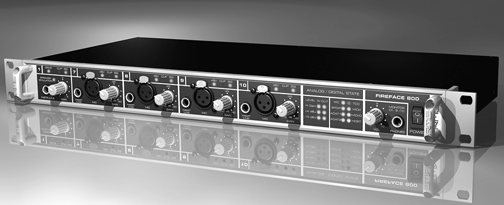
by Steve Cunningham
As I write this, LA has just had another two-week period of 95-plus days, with some well over 100 degrees. Along with that we’ve had our first two stage-one power warnings — that means we’re threatened with rolling blackouts. It’s at times like these that I look at the electronics in my production room, and at the electric bill, and I wonder what can be done to simplify, save a shekel, and lower the studio temp without buying another AC unit. What about that big space heater, the mixing console? We’re all mixing within the computer now, so do we still need a mixer? Is it time to let it go?
Perhaps, but what about gozintas and gozoutas for patching in outboard effects processors? There’s no time to endlessly re-patch too few ins and outs with deadlines looming. What’s needed is an interface with lots of I/O, that sounds really good, and that isn’t Pro Tools-level spendy.
There’s a new interface from RME Audio that may very well do the trick. The Fireface 800 is an external audio interface with 28 channels of input and 28 channels of output, all in a single rack space box that connects to your computer using the IEEE-1394 standard, also known as Firewire.
S-S-SMOKIN’
The Fireface 800 is a 56-channel interface that handles 16 and 24-bit audio at sample rates up to 192 kHz. It offers eight balanced line inputs and eight balanced outputs, 16 channels of ADAT I/O, and four microphone preamps. According to RME, the line outputs perform at up to 119 dBA dynamic range on playback, with a frequency response of -1 dB from 1 Hz to 21.1 kHz. To be sure, those are some exceptional specs.
The system requirements include a PC running Windows 2000 or XP, or a Mac running 10.2.8 or higher. The Mac drivers were not available during the review period, so a Windows 2000 laptop and an XP desktop computer were used. Installation is a matter of connecting the interface, allowing Windows to recognize it as new hardware, and pointing Windows to the included CD with the drivers on it. Also included on that CD are software programs to control every setting on the Fireface, with the exception of the mic preamp levels and the headphone outputs.
The only controls on the Fireface itself are on the front panel. Leftmost is Input 1, the FireFace’s Hi-Z instrument input for guitar and bass, and it includes a software limiter that provides overload protection for the A/D converter. This limiter deliberately creates harmonic distortion, and according to RME “can be used as a distortion with tube-like sound” when the input signal lights the LIM LED above the gain knob. I don’t think the limiter sounds much like tube distortion, but it’s interesting as an effect. Additionally, a DRIVE circuit gives the instrument signal an additional 25 dB of gain, and that gain does sound like guitar distortion.
A Speaker Emulation module rounds out the “guitar wizard” collection on Input 1, by rolling off a bit of low and high end and adding a presence boost in the upper midrange. Input 1’s effects won’t replace a Mesa Boogie amp but it’s all good fun, and you’ll likely find it a useful effect on occasion. More importantly, you can also bypass all of that stuff and simply use Input 1 as a standard, clean line level input.
Next to Input 1, the Fireface 800 has 4 discrete balanced microphone inputs with class-A mic pre-amplifiers, 48 V phantom power, and separate XLR and 1/4" jack inputs; the latter can be used simultaneously with the XLRs as additional line inputs. The rightmost pair of mic inputs are channels 9 and 10, while the other two are designated as channels 7 and 8, and those XLRs can be used separately or together with the 1/4" inputs 7 and 8 on the back panel. This means that you can record up to three separate sources into each of channels 7 and 8. Rounding out the front panel are a bank of LEDs to indicate input level, digital sync status, and sample rate, plus analog outputs 9 and 10, which double as headphone outputs.
Every line input and output on the Fireface (except outputs 9/10, which are unbalanced) is on a balanced TRS 1/4" jack. The inputs are built to correctly handle both balanced and unbalanced signals. The manual recommends connecting the ring of a TRS jack to ground when using it for unbalanced audio, which is generally a good idea anyway.
The two ADAT jacks let you connect recorders, effect devices, external converters or even mixing consoles that have either ADAT optical or S/PDIF optical connectors. Even the S/PDIF I/O works at up to 192 kHz, so when you’re working at high sample rates you’ll still have 10 analog inputs and outputs, plus two digital ones. This is slightly different than other high-sample rate interfaces that penalize you by half your I/O as well as half your jacks when you kick up the sampling rate.
All of the balanced line inputs have software-controlled switching of their reference levels (-10 dBV, +4 dBu, or HiGain). Moreover, all inputs and outputs can be used at the same time. For example, the instrument input can be used instead of the line input on the back, or together with it. Even the jack and the XLR sockets of the microphone inputs can be used simultaneously. This allows you to connect up to 35 signal sources to the Fireface 800, and record them onto 28 separate tracks. Yow, that’s a lot of gozintas and gozoutas.
